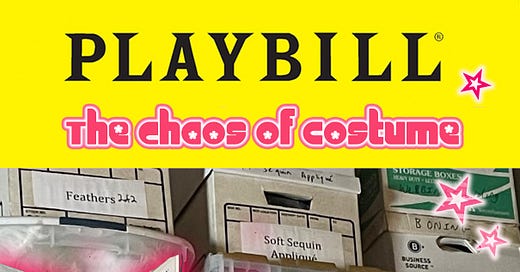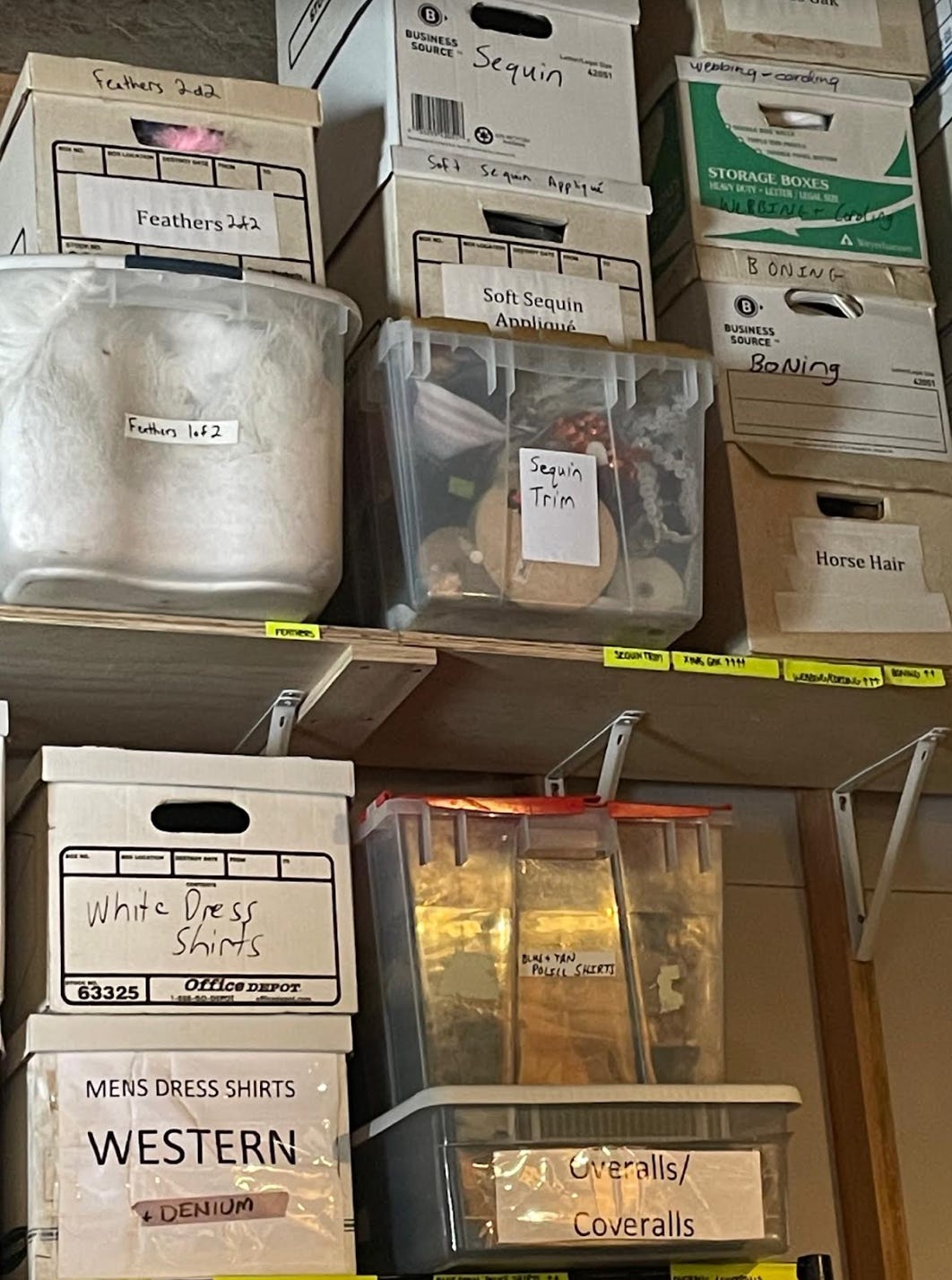Howdy and welcome to this weeks slumber party. Obviously, as this is a fashion blog, I have knowledge and experience in a wide variety of fashion-y topics, yet one of my stranger areas of expertise is that of local theater costume design. I know that this may seem like an extremely niche topic. Hear me out - it is, but I think it is niche enough and strange enough to make it interesting for all of y’all. Theater is a wild place and theater people are even wilder. There is so much that goes into costuming a production, and honestly, a lot of the skills do not transfer anywhere useful outside of that specific role. It is such a weird experience, with such a weirdly specific skill set, and I’ve been dying to put it in writing for you to feast your eyes on.
After lockdown ended, but while still working from home, I was bored out of my mind, my job was feeling stale, and I needed to learn something new. I needed a side hustle. My favorite things besides all-things-fashion are movies, so I decided that I’d take steps to transition my career to film-costume design. (Note - this is still my dream job. Film people please hire me to costume stuff.) I had no experience in costume, and was living in the Bay Area at the time, so my first stepping stone in this pipe-dream career transition would be theater costuming. I spent a rainy afternoon cold-emailing local theaters all over the Bay Area, listing my fashion design skill set and begging for a chance to help out in costuming. I received an email back from exactly one theater, and we were off to the races. Since then, I’ve been a costumer on two shows, and they were vastly different experiences. Each show was at a different theater - the first being filled with awesome, honest, hilarious people who immediately made me feel at home. The second theater being one filled with people who didn’t pay anyone on time and locked me out for a couple hours one day. Either way, my experience in costume design has taught me a lot, like how to change someone from a peasant to a princess in 7 seconds flat, how to use vodka to get rid of lingering body odor, how to make a pair of suspenders stay on a pair of pants while someone scoots across the floor and does the splits in them every single night, and much, much more.
We’ll organize this like the Good, the Bad, and the Ugly - but starting with the Bad.
A huge part of theater costuming is quick-rigging. (Even typing out that phrase puts a shiver down my spine. I really dislike it.) Like I said above - I can change an actor from being peasant Cinderella to blue-gown Cinderella in like 7 seconds flat. This is done by creating essentially an abomination of a garment closure. Something unique to theater costuming is that the construction and sewing don’t have to look good if the audience can’t see ‘em. It’s all done to make life easier for the cast and crew, and there’s not anyone in the audience assessing how pretty the internal sewing is on a garment that’s up on a stage. We’ll take out zippers and put in snaps instead. Buttons are replaced with magnets, hook-and-eyes, snaps, and more snaps. Also - all these little bitches are sewn by hand. You can’t use a machine to sew snaps onto pairs of pajama pants for everyone in a 17-person-cast. Because a huge amount of local theater costume pieces are rentals, all tailoring is reversible, a.k.a - leave extra seam allowance on everything, no serging, and no cutting. The inside construction of these rigged, faux-tailored pieces are hot garbage, but the audience would never know it.

While on the topic of quick-rigging, let’s get into my most personal experience with the painful process. During the first show I ever costumed, I had to be backstage for every single show, because I had the duty of doing an onstage quick change. There’s a scene in Into the Woods where the ugly old witch drinks the milk from Milky White and suddenly turns into a beautiful witch. Onstage, we did this with a lot of smoke machines and a lot (like, way too many) magnets. The actor playing the witch would put on her gorgeous white dress underneath, and on top of that, we’d layer her “evil” black dress. The back of the black dress was completely lined with magnets that snapped together, so we’d just snap the dress up the back before sending her out for the big reveal. She would walk on stage, do her thang, and once the smoke machines came on, that was my cue. I had neon green hair at this time, so I stashed a black beanie side stage that I’d cover my head with, and crouch behind the smoke machine until the witch stumbled back. I ran up behind her, ripped her dress, gloves, and mask off (magnets!) and run / crouch / stumble away, never being seen by a single soul. The big reveal would happen once she went back out in her bedazzled white gown. This little onstage act gave me SO much anxiety every night - I thought I’d signed up to design costumes, and here I was on stage, solely responsible for letting the witch have her big reveal - a pivotal moment in the show.
Now moving on from the Bad, to the Good…
Since I mentioned above that costume pieces are rentals, we can move on from quick-rigging (shudder) and talk about my absolute favorite thing ever - costume rental places. These magical places are heaven for anyone interested in historical costuming, cultural costuming, corsetry, musicals, and so much more…basically all of my favorite things to nerd out on. They exist - usually attached to a specific theater - solely to rent out costume pieces to other theaters, shows, and events like renaissance fairs, the Dickens fair, and other events that require specific costume needs. Rows upon rows of racks are organized by decade, specific production, geography, fabrication - the list goes on and on. I worked closely with rental warehouses during the second show I costumed, which was the Pajama Game. The Pajama Game is a musical set in the 1950’s, so we were scouting mostly vintage suiting, corsets, dresses, and blouses. I carried with me a list of the cast and their general measurements, and got to work. I delved into the 1950’s vintage section of this place like a kid in a candy store. Wool plaid skirts! Itchy pastel cardigans! Satin slip dresses! More itchy wool things! We loaded up rack upon rack, piled it all into the head costume designer’s car, and headed to more rental places. It’s like shopping, but the theater is paying to rent it, you don’t get to keep anything, and you get to see it worn on stage and looking super cute. Win-win?

The next step in the costume design process is running fittings. Fittings are my second favorite thing ever, even in my day job. Garments are divided up by what fits who (what physically fits the body, and what fits the character’s personality) and we take it scene by scene. What would Gertrude wear to the company picnic - the yellow dress, or the blue pants? Next, we note any alterations we need to make - that yellow dress is three inches too long on Miss Gertrude, so we need to do one of our reversible hems to make it fit better / be more period-appropriate. My favorite adjustments to make to these pieces, though, is the fun stuff. Into the Woods is a fantasy production, so we did a lot of work with adding leaves, twigs, sticks, and feathers everywhere we could for several characters’ looks. I’d find myself hunched over on the floor, back looking like a lowercase letter “c”, having just spent 2.5 hours sewing leaves to every inch of the coat for the character aptly named “Mysterious Man.” The creation of a character through styling and design details it what keeps drawing me back to costume design.
From the Good, to finally - the Ugly
What immediately pulls me away from costume design, specifically theater costume design, is what happens after the curtain closes for good. This is known as “strike,” and is potentially the most stressful step in the long, arduous process of costume design. I’ll spare the boring details, but every individual piece has to be collected, rigging/tailoring on rentals undone, dry-cleaned, and returned to their rightful spot on the correct rack in the correct closet. This includes ties, socks, belts, wigs - everything. Think about the laundering process for a moment - cast members have been wearing these pieces, night after night, under hot lights, singing and dancing, giving their all. I mean, these pieces straight-up stink. Hopefully, if you choose to pursue costuming, you work for a theater that will compensate for dry cleaning in a timely manner, because dry-cleaning for an entire cast can get up to around a grand. (IYKYK. Looking at you, theater #2). If you ever try out theater costuming, most importantly, hopefully you’re working with a head designer who uses a lot of excel spreadsheets (thanks Katie, if you ever see this). There’s a lot of little pieces, a lot of laundry, and a lot of warehouses pushing for returns. Get that shit put back and hopefully, eventually, you will stop having all of the songs in the musical stuck in your head 24/7.
I feel like a lot of this post has sounded complain-adjacent, and I really don’t mean it to be that way. I always talk about my times in theater costuming with a bit of an eye-roll, but I would absolutely do it again. Right before moving to LA, I received an offer to costume the Addams Family for a Bay Area theater that I absolutely adore, but had to reluctantly turn it down. This offer gave me insight into the pay that the head designer receives; unfortunately, I must remain a corporate girlie for now (that being said, I could potentially make some time for a side hustle…). Costuming any kind of production is a really special process, and if you do it correctly, the majority of the audience will forget it even exists - that’s when you’ve done your job right. I love to blend my passions for clothing design and entertainment, and using costume to make a character come to life is like basically what I do every day when I get dressed. I just wanted to share this strange, unique experience of mine that I really do cherish, and hope to continue in a different way in the future.
Thanks again sleepover besties! Let me know what production YOU’D want to costume? (My ultimate goal would be a version of Beetlejuice!)





